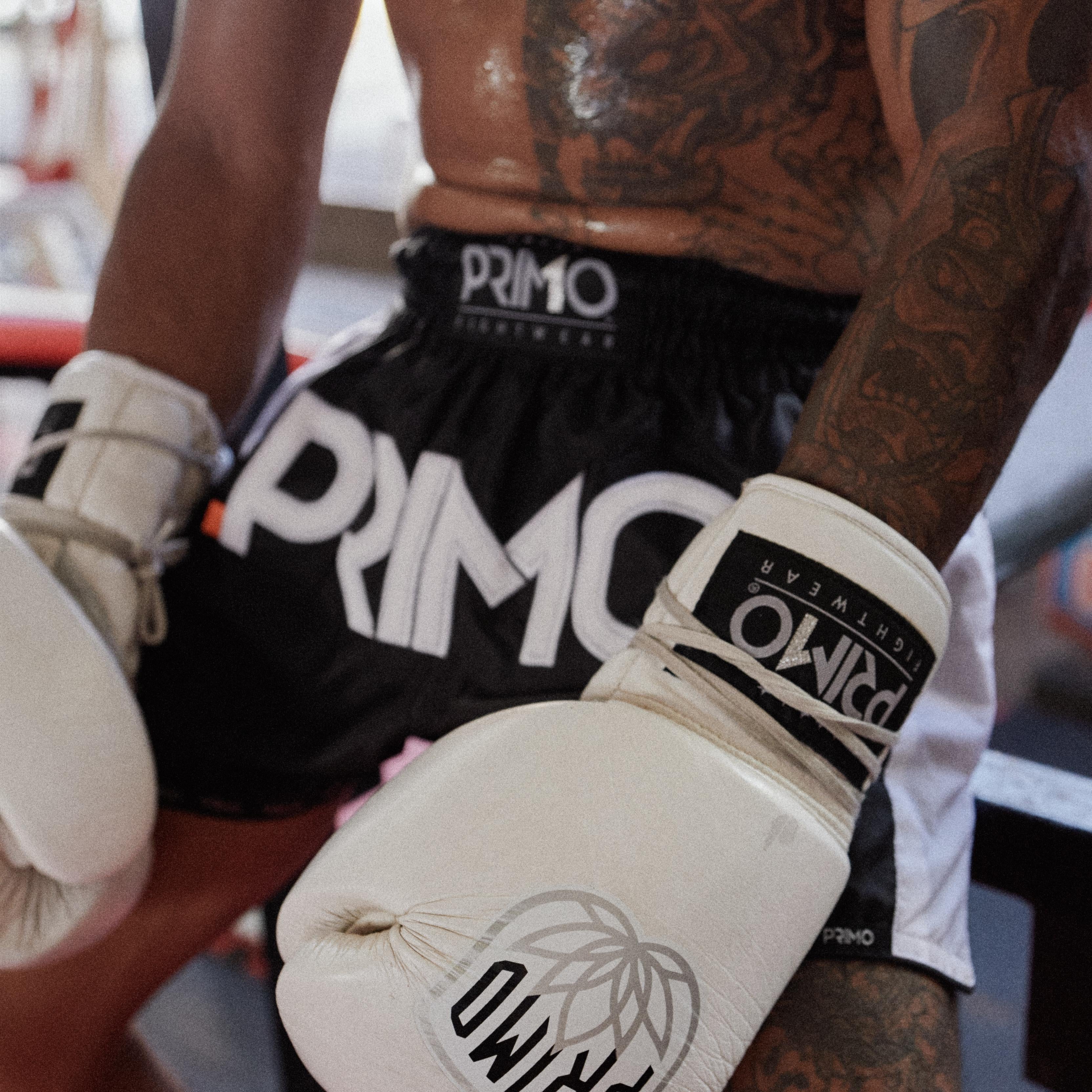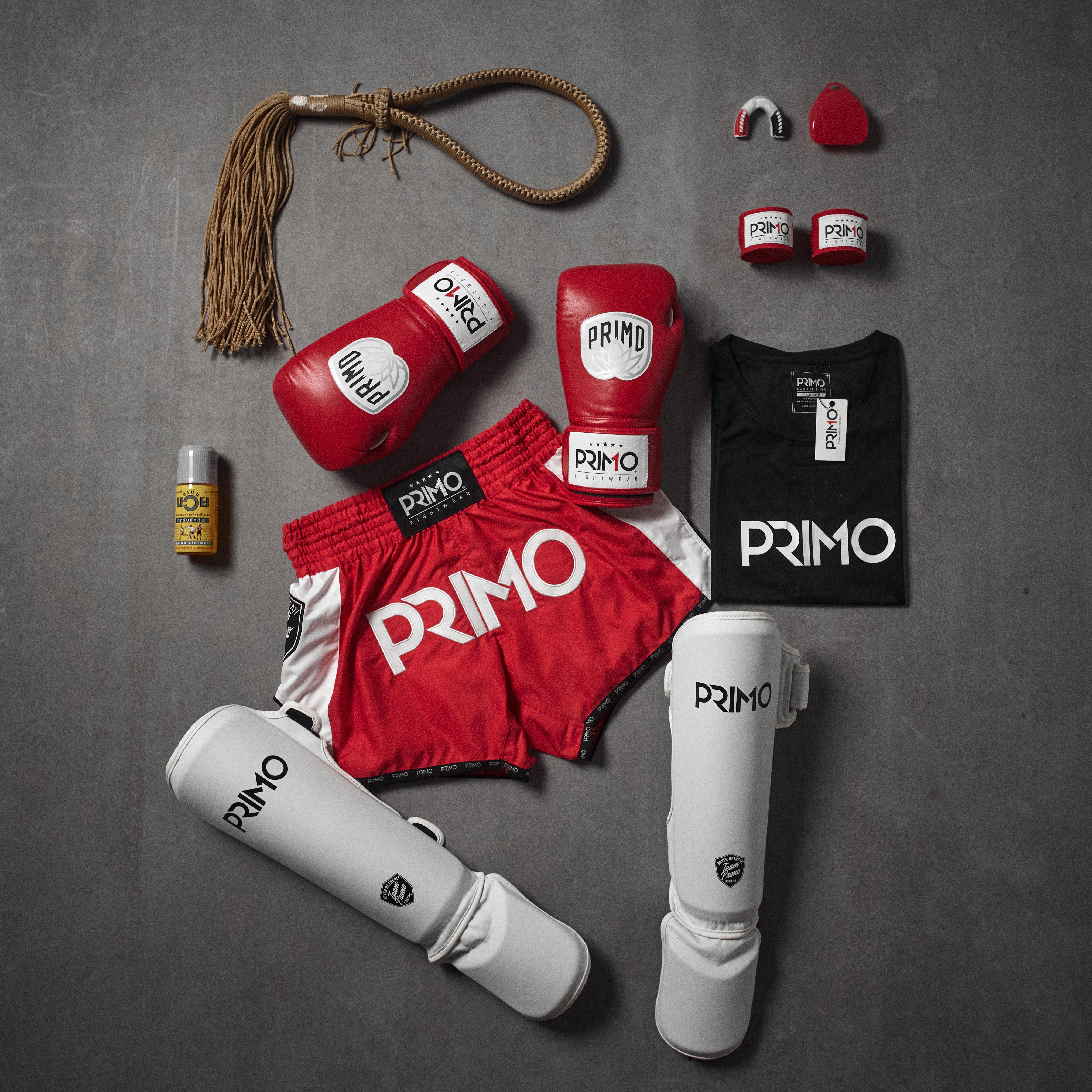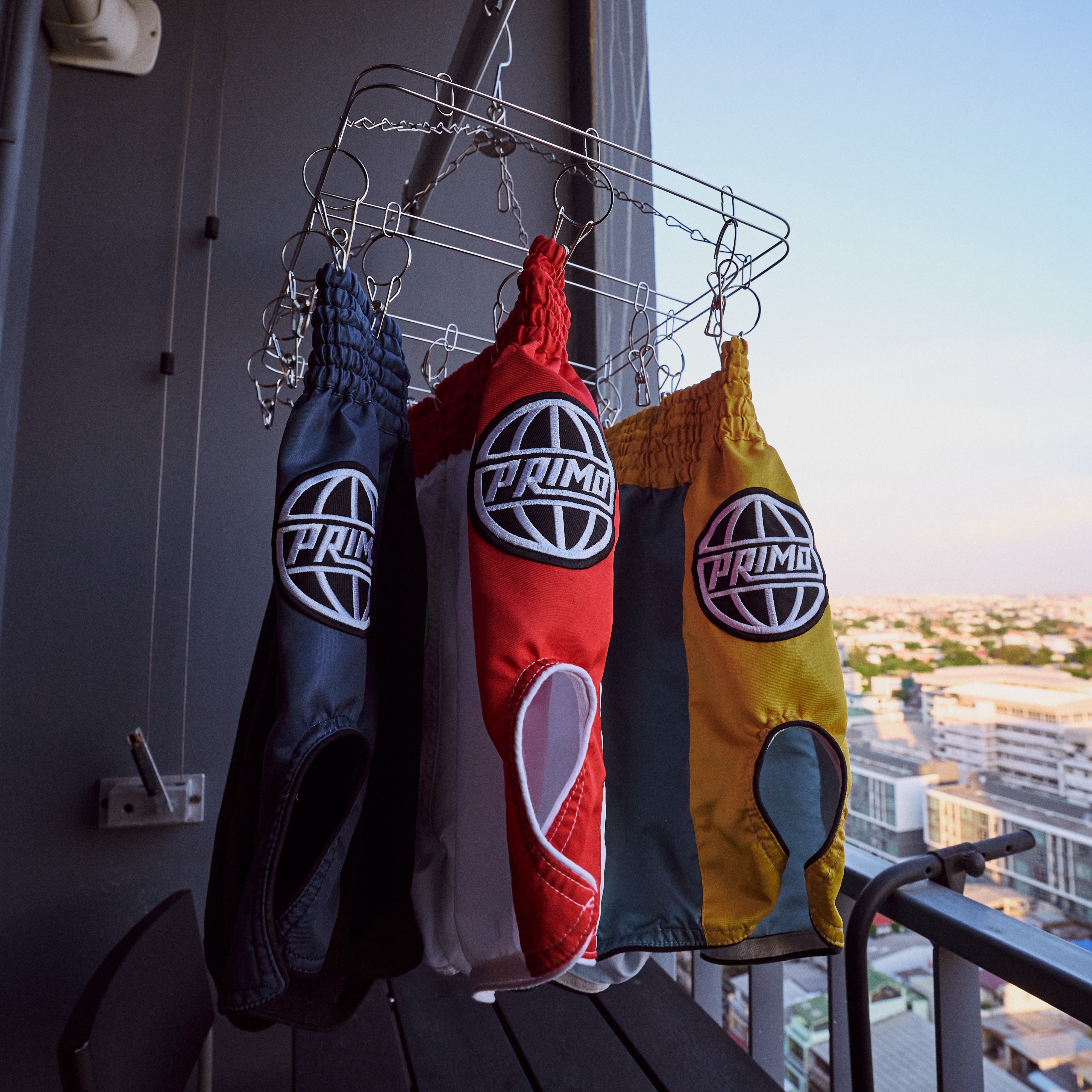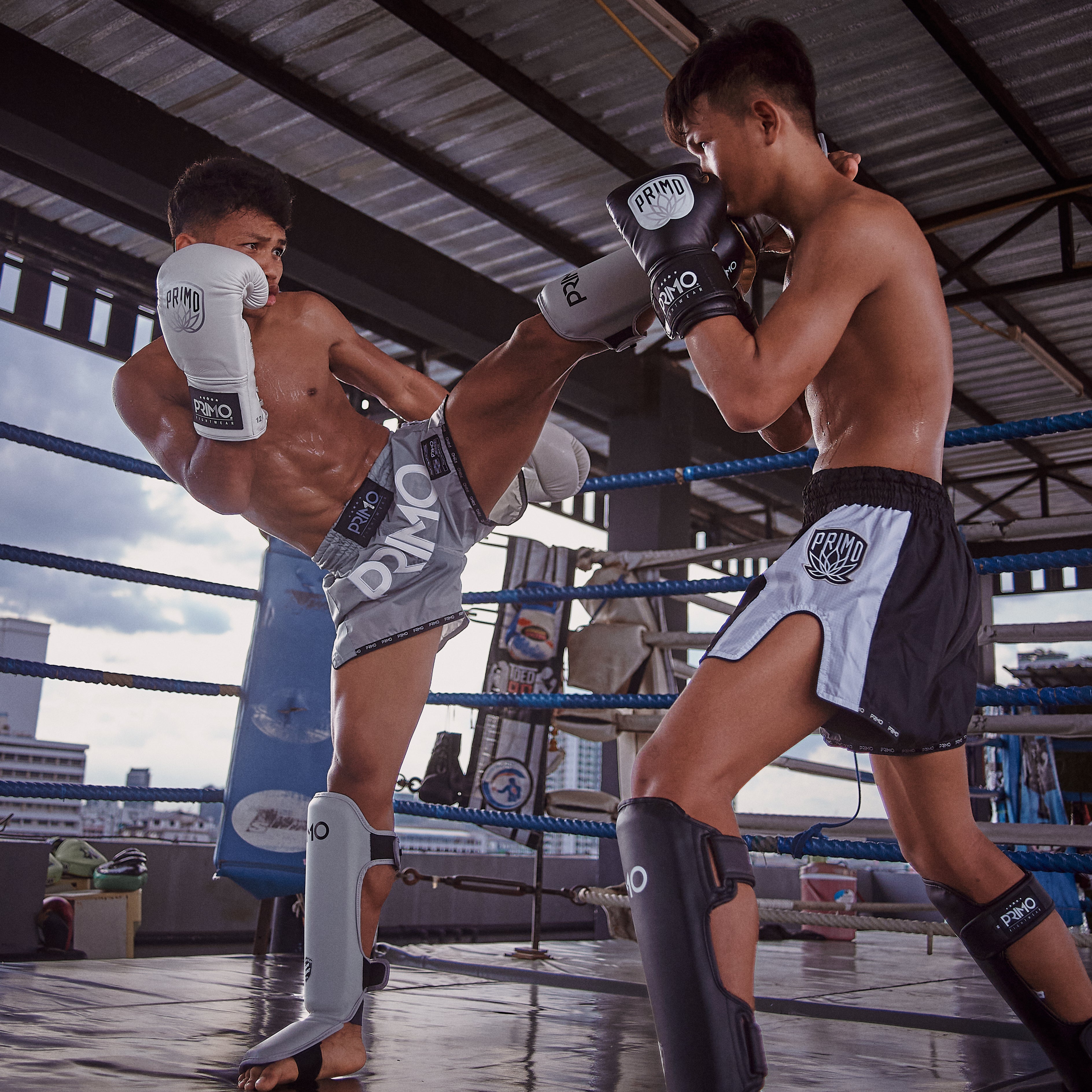
Muay Thai training comes in various shapes and forms. Whether it be intensive cardio, heavy hitting on the punchbag and Thai pads, or technical rounds of sparring. Varied training helps develop your skills and ensures you maximise the physical and mental benefits of the sport. However, you need the right equipment to do so. Equipment that ensures you're safe and can strike smoothly.
That's why we built this Muay Thai equipment guide. To make clear what equipment you need, why you need it and how it helps you maximise your performance. Fortunately, you don't need a lot to enjoy Muay Thai regularly. We list it out below and mark what's essential and what's to nice to have.
1. Muay Thai Gloves: Finding the Right Fit and Size
Muay Thai gloves are the most crucial piece of equipment for any Muay Thai practitioner. They protect your hands during training and sparring, absorbing the impact of strikes and reducing the risk of injury. Your hands and wrists are fragile, with many bones, joints and ligaments. So it's crucial that you don't skimp on gloves as they are the main protective equipment for your hands.
When choosing gloves, avoid pure boxing gloves and look for gloves developed specifically for Muay Thai training, or ones designed for both like our Emblem range. These have more dispersed padding than boxing gloves which helps block and catch kicks comfortably. Look for a snug fit that allows for proper hand and wrist alignment. Ensure the closure is durable. Size wise, we recommend 10-12oz for padwork and bag work. 14-16oz for sparring and drill-work.
We also recommend two pairs for anyone who trains regularly. One specifically for padwork and bag work. Another for sparring and drill-work. Keep their use separate to ensure longevity.
For more details on how to find the perfect pair of gloves and how to care for them, check out this Muay Thai gloves guide.
2. Muay Thai Shin Guards: Essential for Leg Protection
Shin guards are essential for protecting your legs (and your partner) during the likes of drill-work and sparring. Shin on shin contact is uncomfortable for most, so wearing shin guards enable you to kick and check kicks more comfortably and with less risk of injury. There are two types - slip-on or enclosed. Slip-on are typically for amateur competition but can be useful for conditioning in the early stages of your Muay Thai journey. Enclosed have elastic straps for underneath the feet and usually two hook-and-loop enclosures around the calf. They are typically made from leather or synthetic leather (semi-leather) with padding for durability.
Look for shin guards that offer full coverage, including the shin and instep, and provide a secure and comfortable fit. They need to help you move unhindered while staying secure to your legs. Long-lasting straps and lightweight materials are key for longevity. With proper shin guards, you can confidently practice your kicks and blocks without worrying about potential injuries. This guide helps you find the best shape and fit for your needs.
3. Hand Wraps: Protecting Your Most Valuable Assets
As mentioned above, your hands and wrists are fragile. Even a slight injury can put you out of training for a while. Doing everything to maximise their safety is a smart move for all types of Muay Thai training. That's why we consider hand wraps as essential. They help stabilize the bones and joints, reducing the risk of sprains and fractures during impact. When wrapping your hands, make sure to distribute the tension evenly and cover all the necessary areas, including the knuckles, wrist, and thumb. It can take a while to learn how to effectively wrap your hands. Most people will have a slight nuance in their method. What's important is you have a solid foundation that's secure and comfortable across your hands, wrists and digits.
Hand wraps come in various lengths and materials, so choose ones that suit your preference and provide sufficient support for your training sessions. Find your perfect pair here.
4. Muay Thai Shorts: Combining Comfort and Tradition
While only strictly essential for competition, we consider Muay Thai shorts an essential part of any practitioner's gym bag. This is because they are specifically designed to maximise movement and comfort during the rigours of Muay Thai training. Their designs, shape and characteristics also symbolize the rich cultural heritage of the sport. Look for shorts made from lightweight and breathable materials that allow for unrestricted leg movement.
Muay Thai shorts are typically short in length and have an elastic waistband for a secure fit. They come in a variety of vibrant colors and designs, reflecting the unique culture and traditions of Thailand. If you're training more than once a week, we recommend multiple pairs. This helps ensure you can clean them properly between sessions. We experiment with colours, fits and materials across our range, so you're bound to find the perfect pair.

5. Mouthguard: Ensuring Dental Safety
Safety should always be a top priority in any combat sport, and Muay Thai is no exception. A mouthguard is a crucial piece of equipment that protects your teeth and jaw from impact during training or sparring. It helps absorb and distribute the force of strikes, reducing the risk of dental and head injuries. Do not neglect the importance of the protection these offer as it can you cost you more than a hefty medical bill.
Look for a mouthguard that offers a comfortable fit and allows for easy breathing and speaking. Custom-fit mouthguards are highly recommended for optimum protection but you can achieve sufficient comfort and protection with boil and bite mouthguards. Remember, a small investment in a quality mouthguard can save you from expensive dental procedures. Once you get a mouthguard, wear it for all drill-work and sparring - it's not worth the risk not to!
6. Headguard: Minimizing the Risk of Head Injuries
Headguards aren't as common in Muay Thai gyms as it they are in boxing gyms. This is because of the variety of striking points in Muay Thai compared to boxing. Besides protecting the nose, the jury is still out on whether headgear actually helps protect your head (and especially your brain) during sparring. Regardless, we consider this as a nice-to-have piece of equipment in general, although likely an essential piece if competing or sparring heavily on a regular basis.
There are a variety of options for headgear. Some provide more comprehensive levels of coverage than others. We recommend headguards that provide full coverage for your head, including the temples, forehead, and chin. It should have adequate padding to cushion the impact and adjustable straps for a secure fit.
7. Ankle Supports: Stability for Your Footwork
Footwork is crucial in Muay Thai, and ankle guards (also know as ankle supports or anklets) can help provide stability and support during movement. They can help minimize the risk of ankle sprains and protect the ligaments from strain. However, not everyone finds them beneficial and while they may be considered essential by some, others will not bother or consider them a nice to have.
Look for ankle guards that offer compression and support without restricting your movement. They should be comfortable and breathable to wear during training sessions. While all quality brands create ankle guards that offer this, for decades they only produced them in limited colours with different colours between the trim and body. We changed that with our monochrome collection.
8. Skipping Rope: For Cardio and Agility
Skipping, or jump rope, is a classic cardio exercise for Muay Thai and boxing. Often used as part of a warm-up and cool-down, skipping is great for building cardio, improving footwork, coordination, speed, and agility. A skipping rope is essential for any gym bag. Although not all ropes are the same. Some are thin and lightweight (speed ropes), which are best designed for speed and intensive cardio. Others are heavier with a thick rope (Thai rope). These also help with cardio while building shoulder and arm strength.
Look for a skipping rope that is suitable for your height and offers a comfortable grip. Adjustable ropes are ideal to customize the length according to your preference.

9. Focus Mitts: Sharpening Your Accuracy and Speed
A gym essential, but not necessary for individuals.
Focus mitts are small, lightweight striking pads that enable coaches to work with students on accuracy, speed and precision. They come in a variety of shapes and sizes. Some are very small and are mainly for boxing. Others are a bit larger and curved and can be used to train all manner of strikes and combinations - this is especially the case with hybrid pads.
When choosing focus mitts, ensure they have enough protection for the wearer. This includes finger protection, thick padding that absorbs strikes and, ideally, a wrist support section. The mitts should be comfortable to hold and allow for easy manoeuvrability. . Using focus mitts regularly can help sharpen your accuracy, timing, and overall striking skills.
10. Thai Pads: Perfecting Your Kicking Technique
A gym essential and a nice to have for individuals, especially those who have training partners they can work with outside the gym.
Thai pads, also known as kick pads, are essential for perfecting your Muay Thai technique. Thick and durable, Muay Thai pads emit a cracking sound when struck with a well placed, powerful kick - a sound synonymous with Muay Thai gyms. They are essential training equipment for any gym and coach. They are the staple equipment to train all Muay Thai kicks, knees, punches and elbows. When coupled with belly pads and shin guards, a coach can work students on all types of training, including power development, fight strategy, clinching and more.
Look for pads that offer sufficient padding to absorb the impact of strikes and protect the holder's hands and forearms. They should have secure straps and a comfortable grip for the holder. Incorporate Thai pad drills into your training sessions to enhance your kicking technique and overall skill level in Muay Thai.
11. Punching Bags: A Must-Have for Power Training
We consider these an essential to any Muay Thai gym. Not every gym has punch bags and they will make up for it with drill-work and pads etc.. Yet training on a punch bag from time to time is essential in skill develop and conditioning, so we've included it as an essential bit of kit. If you can get one for your home, that's an added bonus to this checklist.
Hitting a heavy bag is a great way to test cardio, build creativity and develop conditioning. When choosing a punching bag, consider the size, weight, and material that best suits your training needs. Heavy bags are excellent for power training, while lighter bags allow for speed work. You need to be mindful of how you will mount the bag as this may impact the weight of the bag - after all you don't want to get one that is too heavy for your mount as you'll ending up ripping out part of your ceiling!

12. Elbow and Knee Pads: Extra Protection for Sparring
When sparring, there's always a risk of injury. Especially if going hard or using elbows. Elbow and knee pads are useful for maximising protection in these cases. While they're not essential, it's recommended to use elbow pads when sparring with elbows. Knee pads can be useful for minimising damage when sparring hard or focusing on knee strikes.
Both sets of pads provide extra cushioning and protection for both you and your partner during clinching and striking exchanges. Look for elbow and knee pads that offer a snug fit and are made from durable materials to withstand the impact of strikes and falls. They should be comfortable to wear and allow for a full range of motion.
Maintaining Your Equipment: Tips and Tricks
A full set of Muay Thai equipment is an investment. One you need to maximise through your training and extend through maintenance. Here are some tips and tricks to keep your Muay Thai gear in top shape.
Leather Goods
To keep your leather & semi-leather gear in top condition, regular cleaning and care are essential. Take them straight out of your bag once your home from training. Then start by wiping down your gear with a damp cloth after each training session to remove sweat and dirt. Avoid using harsh chemicals or abrasive cleaners as they can damage the materials. Instead, use a mild soap or leather cleaner and a soft brush to gently clean the surface.
Gloves are notorious for developing odours if not cleaned regularly. This is due to the accumulation of sweat and bacteria. Once this odour develops, it can be stubborn, so preventative care is key. After every session, as part of the cleaning regime, open up the enclosure and allow them to completely dry out before storing them. Avoid leaving your gloves in a closed space or a gym bag for an extended period as it promotes the growth of bacteria. You can use deodorizing sprays or inserts specifically designed for boxing gloves once dry to help further minimise odours. Additionally, you can sprinkle baking soda inside your gloves and let it sit overnight to absorb any lingering unpleasant smells.
Shorts & Apparel
Muay Thai clothing and shorts can be delicate. So it's important to closely read any cleaning instructions that come with them. For t-shirts and tank tops, often a cold wash with a mild detergent, followed by air drying, is enough for a thorough clean. Muay Thai shorts usually need more attention and care due to the variety of delicate materials on them.
We recommend a hand wash with mild soap, followed by air drying. Store them away from direct sunlight and never in a dirty gym bag. We have a detailed guide on how to clean Muay Thai shorts here.






Leave a comment